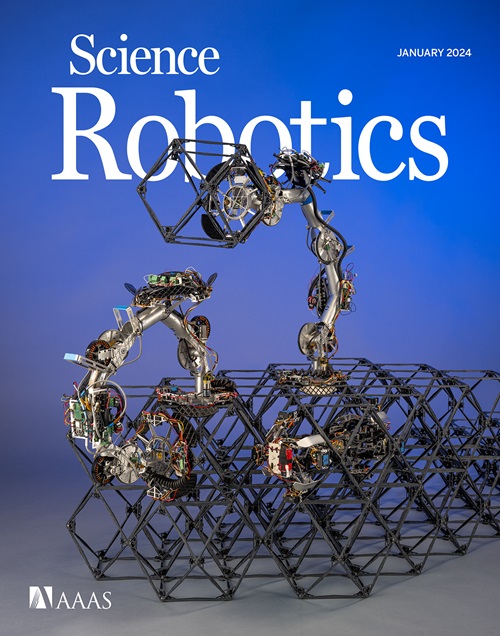Optogenetic neuromuscular actuation of a miniature electronic biohybrid robot
IF 27.5
1区 计算机科学
Q1 ROBOTICS
引用次数: 0
Abstract
Neuronal control of skeletal muscle function is ubiquitous across species for locomotion and doing work. In particular, emergent behaviors of neurons in biohybrid neuromuscular systems can advance bioinspired locomotion research. Although recent studies have demonstrated that chemical or optogenetic stimulation of neurons can control muscular actuation through the neuromuscular junction (NMJ), the correlation between neuronal activities and resulting modulation in the muscle responses is less understood, hindering the engineering of high-level functional biohybrid systems. Here, we developed NMJ-based biohybrid crawling robots with optogenetic mouse motor neurons, skeletal muscles, 3D-printed hydrogel scaffolds, and integrated onboard wireless micro–light-emitting diode (μLED)–based optoelectronics. We investigated the coupling of the light stimulation and neuromuscular actuation through power spectral density (PSD) analysis. We verified the modulation of the mechanical functionality of the robot depending on the frequency of the optical stimulation to the neural tissue. We demonstrated continued muscle contraction up to 20 minutes after a 1-minute-long pulsed 2-hertz optical stimulation of the neural tissue. Furthermore, the robots were shown to maintain their mechanical functionality for more than 2 weeks. This study provides insights into reliable neuronal control with optoelectronics, supporting advancements in neuronal modulation, biohybrid intelligence, and automation.
微型电子生物混合机器人的光遗传神经肌肉驱动
神经控制骨骼肌的功能是无处不在的跨物种运动和做工作。特别是,生物混合神经肌肉系统中神经元的涌现行为可以促进生物激励运动的研究。尽管最近的研究表明,神经元的化学或光遗传刺激可以通过神经肌肉连接(NMJ)控制肌肉驱动,但神经元活动与肌肉反应调节之间的相关性尚不清楚,这阻碍了高水平功能生物杂交系统的工程设计。在这里,我们开发了基于nmj的生物混合爬行机器人,该机器人具有光遗传小鼠运动神经元、骨骼肌、3d打印水凝胶支架,以及集成了基于无线微发光二极管(μLED)的光电器件。通过功率谱密度(PSD)分析研究了光刺激与神经肌肉驱动的耦合关系。我们验证了机器人机械功能的调制取决于对神经组织的光刺激频率。我们证明了在对神经组织进行1分钟的脉冲2赫兹光学刺激后,肌肉持续收缩长达20分钟。此外,这些机器人的机械功能可以维持两周以上。这项研究为可靠的光电子神经元控制提供了见解,支持了神经元调制,生物混合智能和自动化的进步。
本文章由计算机程序翻译,如有差异,请以英文原文为准。
求助全文
约1分钟内获得全文
求助全文
来源期刊

Science Robotics
Mathematics-Control and Optimization
CiteScore
30.60
自引率
2.80%
发文量
83
期刊介绍:
Science Robotics publishes original, peer-reviewed, science- or engineering-based research articles that advance the field of robotics. The journal also features editor-commissioned Reviews. An international team of academic editors holds Science Robotics articles to the same high-quality standard that is the hallmark of the Science family of journals.
Sub-topics include: actuators, advanced materials, artificial Intelligence, autonomous vehicles, bio-inspired design, exoskeletons, fabrication, field robotics, human-robot interaction, humanoids, industrial robotics, kinematics, machine learning, material science, medical technology, motion planning and control, micro- and nano-robotics, multi-robot control, sensors, service robotics, social and ethical issues, soft robotics, and space, planetary and undersea exploration.
 求助内容:
求助内容: 应助结果提醒方式:
应助结果提醒方式:


